Hops in Beer Brewing: Groene Bel
Published: October 17, 2025 at 10:57:30 PM UTC
Groene Bel hops, also known as Green Belle hops or Green Bubble Belle, are a long-lost Belgian aroma variety. They intrigue brewers and historians alike. Once grown from clonal selections of Aalst region stock in the late 19th or early 20th century, these hops provided a gentle, continental fragrance to ales before World War II reshaped hop choices across Europe.
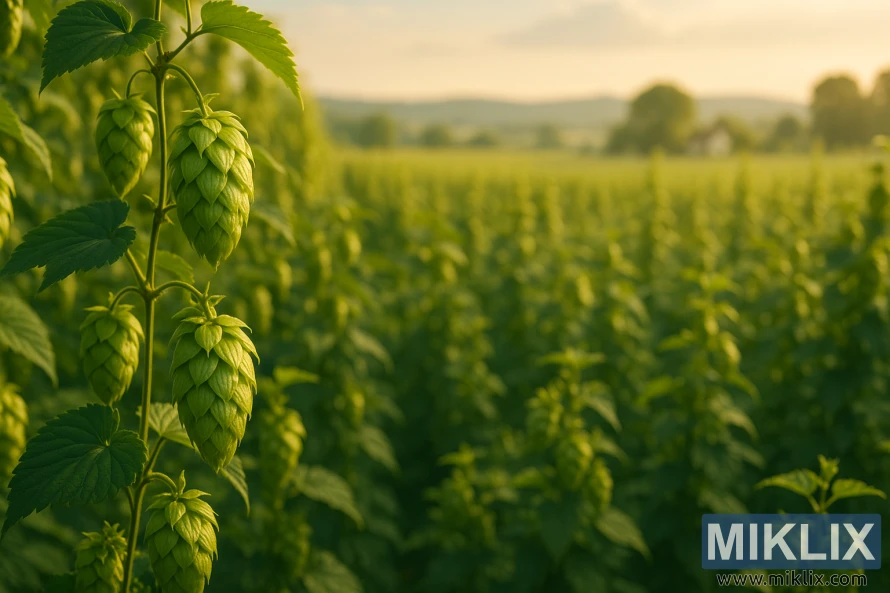
Though not commercially produced today, Groene Bel beer recipes and historical accounts keep the variety alive in brewing literature. Its low alpha acids—commonly cited around 2.0–4.9% with many sources near 4%—make it best suited as an aroma hop rather than a bittering workhorse.
Groene Bel hops surfaced again in hop-breeding programs in places like Zalec, Slovenia in the 1970s, contributing aromatic traits to new cultivars. Craft brewers, recipe builders, and hop historians find value in tracing its profile and influence on modern Belgian-style ales.
Key Takeaways
- Groene Bel hops are a historic Belgian aroma variety also called Green Belle hops.
- The variety is characterized by low alpha acids, favoring late additions for aroma.
- Not commercially produced today, but used historically and in breeding work.
- Groene Bel beer traditions inform contemporary Belgian-style brewing choices.
- Its continental aroma makes it a useful reference for recipe builders and historians.
Introduction to Groene Bel and Its Place in Brewing
Groene Bel started as a Belgian aroma hop, celebrated for its soft, continental aroma. This aroma was perfect for traditional Belgian ales. It was significant in regional brewing before World War II. Now, it's seen as a niche curiosity by today's brewers.
In its time, Groene Bel provided subtle floral and herbal notes without harsh bitterness. Its low alpha acids made it an aroma hop, ideal for late additions and dry hopping. Breweries used it to enhance malt-forward recipes with a refined scent, not sharp bitterness.
Post-war, Belgian breweries turned to well-documented hops like Saaz and Hallertau. These German and Czech hops offered consistent yields and clear records. This shift diminished Groene Bel's role in brewing, leaving modern databases with limited information.
Today, Groene Bel draws brewers interested in heritage flavors or unique aroma textures. The aroma hop overview reveals it can add restrained floral and light spice notes when sourced well. Limited documentation means brewers rely on trial batches and sensory logs to understand its behavior in modern recipes.
- Historical role: traditional Belgian aroma contributor.
- Primary use: late additions and aroma-focused treatments.
- Modern status: scarce records, occasional revival by heritage-focused brewers.
Botanical Background of Groene Bel
The origins of Groene Bel trace back to Flemish hop traditions. It likely emerged from clonal selection of native Aalst hops in Belgium, around the late 19th or early 20th century. Growers chose plants for their aroma and cone quality, shaping the variety known as Green Belle or Green Bubble Belle.
The history of Groene Bel is deeply rooted in Belgian hop culture. Local records and nursery lists highlight aromatic cultivars preferred by small-scale growers and family farms. This heritage explains the incomplete or inconsistent botanical and type fields in modern databases for this hop.
Botanical descriptions of Groene Bel vary due to its limited commercial propagation and lack of formal registration. The absence of standardized entries stems from its rare cultivation and imperfect hop cataloging practices. Despite this, gardeners and craft brewers appreciate its lineage and unique aroma.
- Lineage: clonal selection from Aalst-area varieties.
- Nomenclature: also called Green Belle and Green Bubble Belle.
- Documentation: sparse modern records despite clear Belgian roots.
Understanding Groene Bel's origins sheds light on its place in Belgian hop history. This knowledge is crucial for brewers looking to incorporate it into traditional Belgian styles or experimental brews.
Chemical Composition and Brewing-Relevant Metrics
Brewers depend on hop metrics to plan bitterness and aroma. Groene Bel's alpha acids are low to moderate, often reported around 4.9%. Some sources indicate a range of 2.0–4.9%. This suggests Groene Bel is ideal for aroma and gentle bittering, not for high IBUs.
The beta acids in Groene Bel are typically near 3.5%. Beta acids are crucial for beer's aging and oxidative stability. Co-humulone levels are about 27%, which brewers use to estimate bitterness sharpness and compare options.
Total oil content in Groene Bel is about 0.98 mL per 100 g. This oil composition helps brewers understand the aroma intensity when used in late boil or dry hopping.
Oil breakdown reveals myrcene at 39%, humulene at 32%, caryophyllene at 18%, and farnesene at roughly 2.41%. These components influence floral, spicy, and herbal notes. They guide decisions on yeast, malt, and adjuncts.
- Alpha/beta acid ranges: low alpha, moderate beta—useful for estimating bittering potential.
- Co-humulone ~27%—helps predict bitterness character.
- Total oil ~0.98 mL/100 g—indicates aroma contribution.
- Major oils: myrcene, humulene, caryophyllene, farnesene—inform aroma focus.
When comparing varieties or selecting substitutes, evaluate Groene Bel alpha acids against target IBUs and weigh Groene Bel beta acids for stability. The combined hop metrics and oil profile help recipe builders predict its performance in boil, whirlpool, and dry hop additions.
Aroma and Flavor Profile of Groene Bel Hops
The aroma of Groene Bel hops is reminiscent of traditional continental hops. Oil analysis reveals a significant presence of humulene, complemented by myrcene and caryophyllene. This combination results in a scent that is herbal and slightly floral, without the boldness of citrus or tropical notes.
Upon tasting and smelling Groene Bel, one discovers mild floral notes and a gentle herbal resin. The continental hop aroma provides a subtle background of dry spice and earth. Only when used in large quantities does it reveal a balanced, restrained citrus bite.
The Groene Bel flavor profile is characterized by subtlety. It offers delicate hop herbs, a light floral lift, and faint peppery spice. Its composition leans towards depth over bright fruit esters, making it ideal for recipes where a classic hop voice is desired.
Practical experiences with wort, whirlpool, and dry hop additions confirm the preservation of the continental hop aroma. Late additions enhance floral and herbal notes. Dry hopping, on the other hand, brings out softer spice and a rounded hop presence.
- Primary note: herbal, green hop character
- Secondary notes: mild floral and soft spice
- Absent or low: intense citrus and tropical fruit
Employ the Groene Bel flavor profile when you seek a hop that complements malt and yeast without dominating. It pairs well with pilsner malts, classic ales, and recipes that benefit from a measured continental hop aroma for balance.
Groene Bel hops in Brewing Practice
Groene Bel is celebrated for its aroma, not bittering. Its low alpha acids make it ideal for late additions, whirlpool touches, or dry hopping. It's chosen for its delicate continental floral and herbal notes, enhancing the beer's aroma without increasing bitterness.
In recipes, Groene Bel often constitutes a significant portion of hops. It's allocated about 40–45% of total hop additions. This highlights its importance as a key aroma contributor, rather than a primary bittering hop.
The timing of adding aroma hops is crucial. Adding 5–15 minutes before flameout helps retain volatile oils while minimizing harsh compounds. A short whirlpool at 170–185°F extracts scents effectively. Split additions can distribute aroma over time.
Dry hopping with Groene Bel is straightforward. Use single or staggered doses for three to seven days at cellar temperatures. Cold soaking for 48 hours before fermentation can enhance the extraction of green and floral tones for a more subtle profile.
- Late kettle: 5–15 minutes for a clear aromatic lift.
- Whirlpool: small 10–20 minute additions at 170–185°F.
- Dry hop: 3–7 days, room to cellar temps, single or split doses.
Choosing the right pairings can enhance Groene Bel's impact. Pair it with Saaz or Hallertau for old-world spice and straw notes. Use New World varieties like Citra or Mosaic sparingly to add tropical notes without overpowering the continental character. A clean ale yeast, such as Wyeast 1056 or Safale US-05, will best showcase Groene Bel's aroma.
When planning hop percentages, consider Groene Bel a primary aroma hop. If it makes up about 42% of the hops, the rest should complement or contrast its profile. Use higher-alpha hops early for bittering, then rely on Groene Bel for late and dry hop additions to achieve a balanced, aromatic beer.
Styles That Benefit from Groene Bel
Groene Bel's rich history and distinct aroma make it a perfect match for traditional Belgian beers. It enhances the flavors of dubbel, tripel, and classic Belgian blondes. This synergy brings out the best in these styles.
For those brewing farmhouse ales and saisons, Groene Bel adds a subtle herbal and earthy touch. It's ideal for brewers seeking a balanced flavor profile. This hop variety supports the yeast-driven spice and fruit esters without overpowering them.
Classic Pilsners and continental blond ales benefit from Groene Bel's soft, noble-like aroma. Its low alpha acids ensure a balanced bitterness. This results in a light floral or herbal top note, enhancing the beer's overall character.
- Belgian ales — accentuates bready malt and yeast esters
- Saisons and farmhouse ales — adds earthy, peppery accents
- Classic Pilsners — provides continental ale hops character without harsh bitterness
- Continental blond ales — supports subtle hop aroma for balanced drinking
Don't rely solely on Groene Bel for modern IPAs with a citrus focus. Its true value lies in blending with yeast and malt. This combination creates nuanced, traditional profiles across various beer styles.
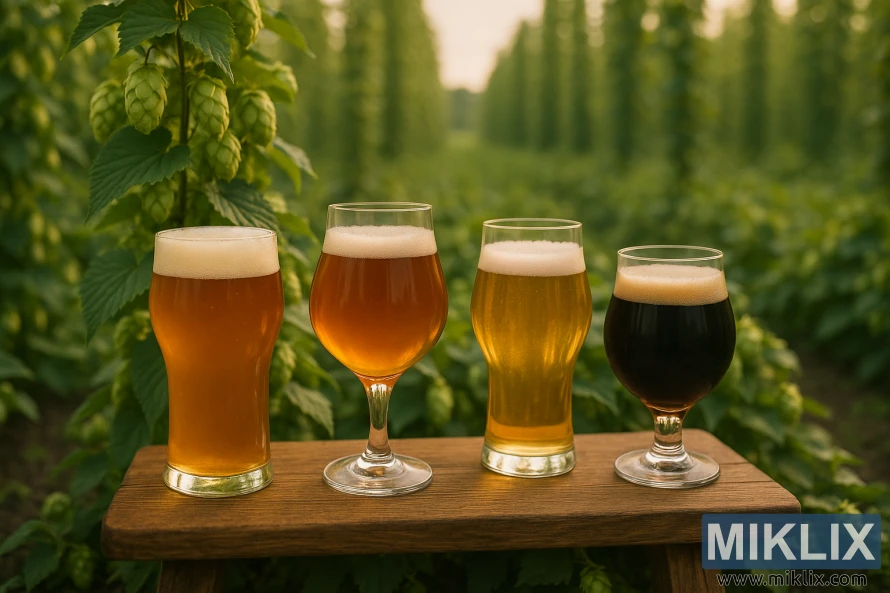
Substitutes and Similar Hops
When Groene Bel is out of stock, brewers can turn to continental aroma hops. These varieties offer a similar spice and floral character. Saaz and Hallertau Mittelfrüh are classic picks, known for their low alpha acids and soft herbal notes.
Saaz is a great substitute for late additions and dry hopping. It brings a straightforward herbal flavor. Hallertau varieties add a rounded floral note, enhancing traditional Belgian and continental styles. These hops maintain a familiar aroma without increasing bitterness.
Consider legacy noble cultivars and modern continental hops with moderate humulene and caryophyllene levels. Opt for hops with low alpha acids to keep IBUs in check while preserving delicate aroma balance.
Practical options for recipe adjustments:
- Saaz — clean, herbal, quintessential continental aroma.
- Hallertau Mittelfrüh — rounded floral and spicy notes suitable for lagers and ales.
- Other noble/continental types — choose ones with similar oil profiles for the closest match.
Test small pilot batches when swapping Groene Bel substitutes to note nuance differences. Adjust timing and quantities of late additions or dry hops to better match the original aroma. Careful tasting helps identify which replacement hops deliver the desired result in each beer style.
Growing Characteristics and Agronomy
The growing characteristics of Groene Bel are based on historical records and field notes. It originated in Belgium and matures mid-to-late in the season. Its growth rate is considered low to moderate, impacting trellis planning and labor needs for small farms and heritage hop plots.
Available agronomic metrics are limited. The reported hop yield for Groene Bel is about 825 kg per hectare, or roughly 740 lbs per acre. This yield is modest compared to many modern commercial cultivars bred for high productivity. Cone density and size data are missing from primary notes, posing practical questions for growers.
Modern cultivation data for Groene Bel is scarce, often listed as "loading" in databases. Its popularity and acreage have declined since the mid-20th century. As a result, up-to-date information on resistance and susceptibility is limited. Growers should anticipate gaps in cold-hardiness, disease tolerance, and pest interaction records.
- Season: mid to late maturity suits summer pruning schedules and staggered harvests.
- Growth: low to moderate vigor calls for careful nutrient and trellis management.
- Yield: hop yield Groene Bel historically modest at about 825 kg/ha.
For those restoring heritage gardens or trialing older varieties, monitoring and recording local performance is crucial. It strengthens the knowledge base for Groene Bel agronomy. Detailed, replicated trials are the best way to fill modern data gaps on this cultivar.
Storability and Handling for Brewers
Groene Bel's storability is modest at ambient temperatures. Data reveal about 58% alpha-acid retention after six months at 20°C (68°F). Total oil is near 0.98 mL/100g. This means aroma hops lose potency if left at room temperature for long periods.
For optimal hop storage, Groene Bel benefits from cold-chain practices. Store hops in refrigerators or freezers whenever possible. Vacuum-sealed packaging or oxygen-scavenged bags slow oxidation and protect volatile oils.
Handling aroma hops requires care during transfer and dosing. Minimize time exposed to air when opening packages. Use clean, dry scoops and tight seals on unused portions to limit oxygen pickup.
- Target temperature: freezer at -18°C (0°F) or refrigerator around 0–4°C (32–39°F).
- Packaging: vacuum pack or use nitrogen-flushed bags to reduce oxygen.
- Use window: aim to use aroma hops within a few months after thawing for peak character.
Alpha retention falls faster at higher temperatures and with oxygen present. When planning recipes, account for reduced bittering from older stock. Expect softer aroma intensity from hops past peak.
Practical tips for routine handling include portioning frozen pellets into smaller sealed bags. Label with pack dates and alpha values. Thaw only the amount needed for a single brew. These steps preserve aroma and make hop storage Groene Bel predictable.
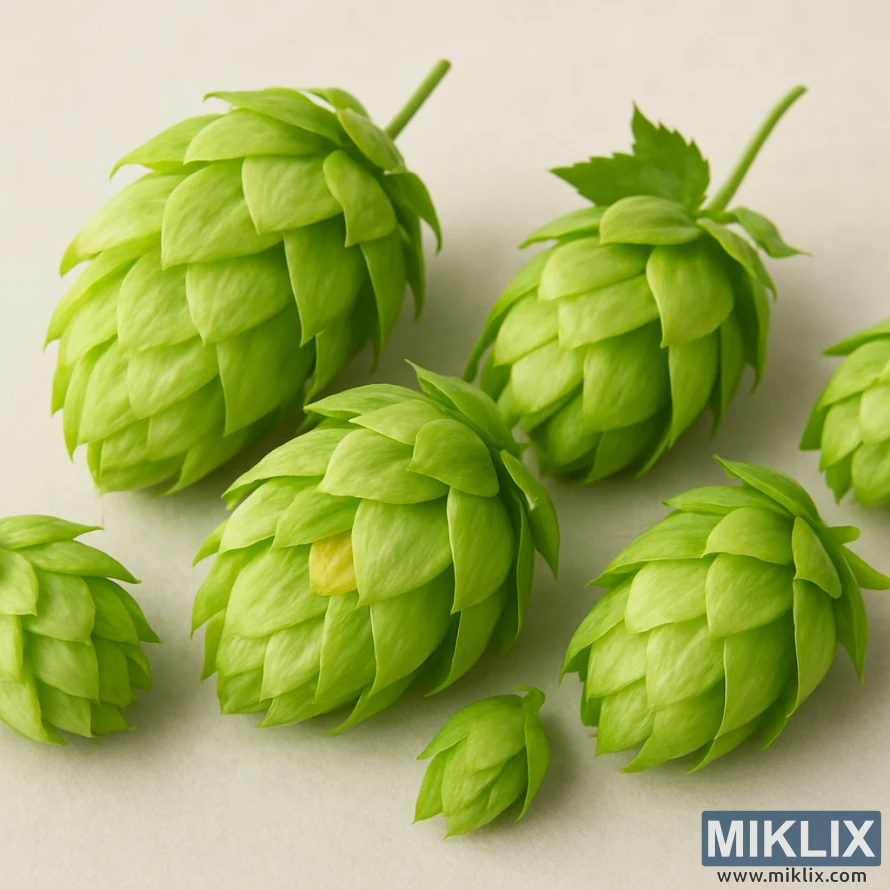
Breeding, Rarity, and Commercial Availability
Groene Bel's journey through brewing history is sparse. It was once a staple in Belgian ales but disappeared post-World War II. The 1970s saw its influence in Slovenia, where it was used in hop breeding.
Today, finding Groene Bel is a challenge. It's not listed by mainstream suppliers. Yet, a few heritage hop nurseries and experimental programs hold onto small collections. Brewers should prepare for limited availability and small quantities.
Public records on Groene Bel are incomplete. This scarcity underscores its status as a rare hop. While it appears in some historical and experimental recipes, it's far from mainstream.
- Check specialty heritage nurseries for plant material or cone samples.
- Contact university breeding programs and national hop collections for access to germplasm.
- Consider trace amounts in experimental batches or as a blending component rather than a single-variety centerpiece.
Finding Groene Bel requires dedication. Suppliers of heritage or experimental hops might ship within their countries. For those tracing its genetic lineage, Central Europe's breeding archives are the key.
Technical Data Summary for Recipe Builders
Quick numeric facts help brewers place Groene Bel in a recipe. Use the Groene Bel technical data below as a starting point for calculations and adjustments.
- Alpha acids: typical ~4.9%, reported as low as ~2.0% in some harvests. Treat this as a variable when computing IBUs with hop recipe builder data.
- Beta acids: ~3.5%.
- Co‑humulone: about 27% of alpha acids.
- Total oil: 0.98 mL per 100 g.
- Oil breakdown: myrcene ~39%, humulene ~32%, caryophyllene ~18%, farnesene ~2.41%.
- Purpose: mainly for aroma; yield ~825 kg/ha; matures mid to late season.
Practical recipe metrics Groene Bel guidance follows a conservative approach. Because alpha acids can vary, calculate bittering using the lower end of the reported range when consistency is key. Use hop recipe builder data to run batch simulations and adjust additions if lab values differ from farm reports.
Many brewers report Groene Bel making up roughly 42% of hop additions in beers where it features. Start with that share for aroma-forward ales, then tweak based on the oil profile: emphasize late additions or whirlpool hops to pull forward myrcene and humulene notes.
- For bittering, assume alpha toward the low side if no lab data exists.
- For aroma, schedule a larger percentage in flameout, whirlpool, or dry hop stages.
- Document actual alpha test numbers and update your hop recipe builder data per lot.
Keep records of actual harvest analyses. Updating your recipe metrics Groene Bel for each lot reduces risk and improves reproducibility.
Pairings and Complementary Ingredients
When pairing with Groene Bel, focus on matching its humulene-rich, continental aroma. Choose malts and yeasts that enhance spicy and herbal notes. Start with a clean base of pilsner or pale malts. Add small amounts of Munich or light crystal to add body without obscuring hop nuances.
For hop blends, select mild noble varieties that complement Groene Bel. Saaz and Hallertau are excellent choices for balancing aromas and keeping bitterness soft. Use these hops in late-hop or dry-hop additions to achieve a layered continental profile.
The yeast you choose is crucial. Opt for Belgian ale strains like Wyeast 1214 Belgian Ale or White Labs WLP500. These strains introduce phenolic spice that harmonizes with Groene Bel. Ferment at moderate temperatures to allow yeast character to blend with hop-derived herbal notes.
When considering adjuncts and spices, use them with caution. Coriander and a touch of orange peel can complement continental hops, but avoid heavy citrus. Light adjuncts like a hint of honey or wheat can enhance aroma without overpowering the hops.
- Suggested malts: pilsner, pale, small percentage Munich, light crystal.
- Suggested hops: Groene Bel with Saaz or Hallertau for balance.
- Suggested yeasts: Belgian ale strains for spicy, phenolic interplay.
- Suggested adjuncts: coriander, restrained sweeteners, sparing orange peel.
When crafting recipes, aim for complementary textures and flavors. Opt for crisp carbonation and a moderate ABV to keep hop pairings Groene Bel expressive. Adjust dry-hop timing to preserve herbal top notes.
Employ a practical blending strategy. Test small batches with varied hop ratios and a single yeast strain per test. Monitor which ingredients amplify spice, add sweetness, or mute hop aroma.
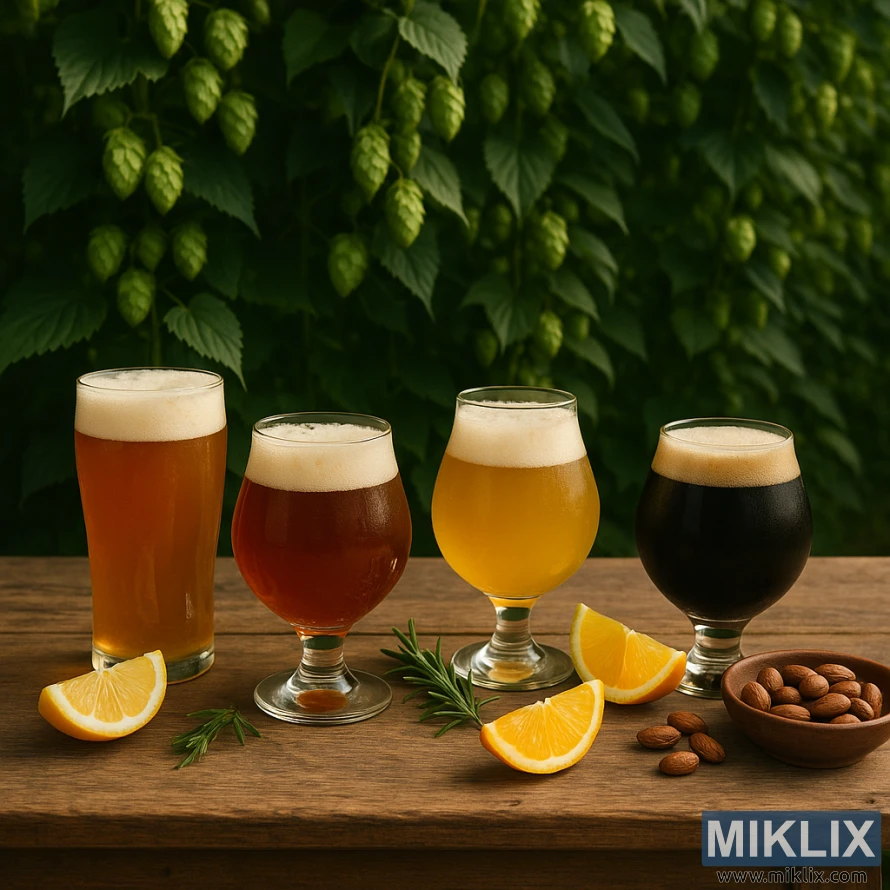
Brewing Recipes Featuring Groene Bel
Groene Bel is ideal for lighter continental lagers and pilsner-style ales as an aroma hop. Use a clean base malt like Pilsner or Münchener to highlight the hop's character. For bittering, classic noble hops such as Hallertau Mittelfrüh or Saaz are best. They provide a subtle backbone and keep IBUs moderate.
Typical usage in Groene Bel beers involves it making up 30–50% of the total hop weight in aroma additions. Aim for late-kettle additions at 10–15 minutes, a significant flameout or whirlpool charge, and a measured dry hop. This enhances floral and herbal notes without overpowering the malt.
Here are three recipe templates that follow documented usage and suit home or small-scale brewers:
- Continental Pils (5 gal): 90% Pilsner malt, 10% Munich; bitter to 28–32 IBU with Hallertau at 60 min; add Groene Bel 10–15 min for 15–25% of hop bill; whirlpool/flameout Groene Bel 25–35% of hop bill; dry hop small touch (5–8 g/L) for aroma.
- Light Kölsch-style Ale (5 gal): 85% Pilsner, 10% Vienna, 5% wheat; bitter to 18–22 IBU using Saaz; Groene Bel at 10 min plus whirlpool to total ~40% of aroma hops; gentle dry hop after conditioning to add a soft continental lift.
- Herbal Session Ale (5 gal): neutral base malts, late bittering hop for 20 IBU; Groene Bel used mainly at flameout and as a dry hop to deliver green, floral tones; keep total Groene Bel weight at roughly 35–45% of the finishing hop schedule.
Practical tips for recipes with Groene Bel hops: mill hops close to use, keep storage cold to preserve volatile aromatics, and stagger late additions to capture both floral top notes and deeper herbal tones. Adjust dry-hop timing to suit fermentation activity for the cleanest aroma transfer.
If Groene Bel is scarce, scale recipes so the hop remains an accent rather than the sole aroma source. These recipes with Groene Bel hops let brewers showcase a historic variety while relying on proven bittering partners to maintain balance.
Common Questions Brewers Have About Groene Bel
Many brewers have a few practical concerns. The Groene Bel FAQ often begins with availability. Today, Groene Bel is not commercially grown in Belgium. It mainly appears in historical records and breeding plots.
Flavor queries follow: what does it taste like? Brewers note a continental, herbal aroma with humulene-driven notes. This makes it a useful aroma hop for lagers and pale ales, aiming for a mild, classic European character.
- Alpha and beta acids: reported averages place alpha near 4.9% and beta around 3.5%, though ranges vary by source and sample.
- Usage frequency and dosage: when included in recipes, Groene Bel often accounts for roughly 42% of total hop additions, mainly for late and whirlpool additions to preserve aroma.
- Substitutions: Saaz and Hallertau are common stand-ins because they share similar continental, herbal qualities that suit the same beer styles.
Brewers often ask about handling inconsistent lab data. Answering those questions about Groene Bel hops means relying on historical metrics, tasting trials, and conservative alpha assumptions during bittering calculations.
Storage and sourcing are frequent topics in the Groene Bel FAQ. Given its rarity, smalllot purchases and cryo or pellet forms from specialist suppliers are typical. Keep hops cold and vacuum-sealed to protect fragile aromatics.
Practical tips for recipe planning address brewer questions Groene Bel directly. Start with aroma additions, adjust alpha assumption downward if lab data is old, and run a pilot 5–10 gallon batch to confirm balance before scaling up.
Lastly, brewers often wonder if Groene Bel fits modern craft styles. Yes, it works well in traditional lagers, rustic Belgian-style ales, and any recipe that benefits from subtle herbal European character without aggressive citrus or resin.
Groene Bel hops
Groene Bel, also known as Green Belle, is a Belgian aroma hop with a high humulene oil proportion. The groene bel overview notes its historical use in Belgian ales and its later role in Slovenian breeding programs. Growers and brewers find few modern commercial plantings in Belgium today.
This short Groene Bel hops summary highlights typical recipe roles. Expect low alpha acids and a dominant aroma purpose. In blends where it appears, Groene Bel often accounts for roughly 40–45% of total hop weight. It's used to lift floral and herbal notes without driving bitterness.
- Identity: Belgian aroma hop, high humulene oil.
- Usage: aroma-focused, low alpha acids.
- Availability: rare commercially in Belgium; details rely on historical records and breeding notes.
Many modern hop databases show incomplete entries for this variety. That gap makes the Green Belle hops summary reliant on archival sources and breeding records for brewing guidance. Brewers should treat available data as indicative rather than exhaustive.
This concise Groene Bel overview serves as a quick reference for recipe builders and historians. It aggregates identity, common usage patterns, and current rarity. This helps decide if Groene Bel fits a given beer concept.
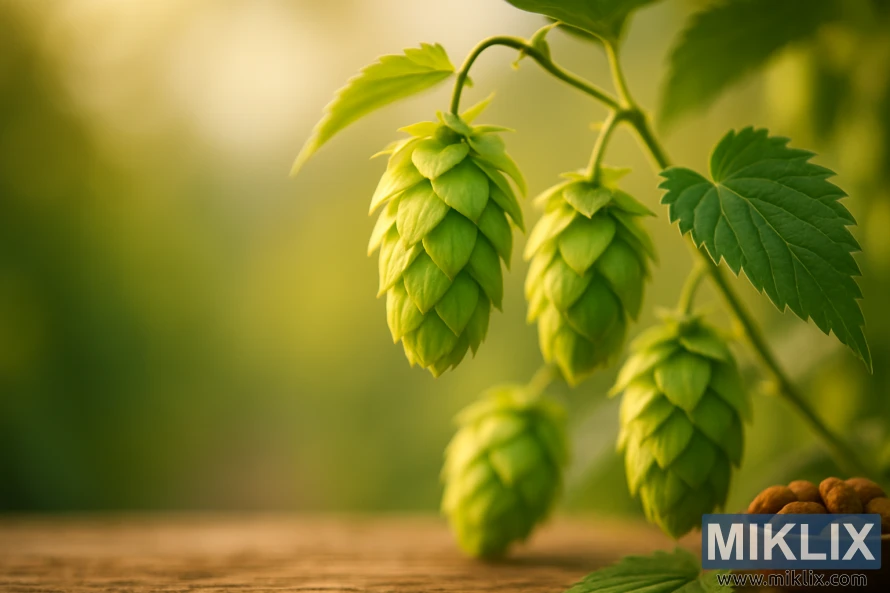
Conclusion
Groene Bel conclusion: This heritage Belgian aroma hop brings a soft, continental character. It's best used as a late addition or for dry hopping. Its notable humulene presence and modest oil and alpha metrics make it ideal for aroma rather than bittering. Brewers looking for soft spice, hay, and herbal notes will appreciate Groene Bel most when added in the whirlpool or during fermentation.
Groene Bel brewing takeaways highlight its role as a low-alpha aroma hop. Recipes should be planned with its strengths in mind. It's perfect for enhancing pilsners, saisons, and classic Belgian ales with delicate continental aroma. For bittering, pair it with higher-alpha hops like Magnum or Nugget early in the boil. Reserve Groene Bel for late or dry additions.
Availability is limited, so source from specialty suppliers or consider substitutes like Saaz or Hallertau when stock is unavailable. Store hops cold and vacuum-sealed to preserve alpha acids and volatile oils. These practical notes encapsulate the essence of Groene Bel, emphasizing its benefits and brewing applications for both recipe builders and commercial brewers.
Further Reading
If you enjoyed this post, you may also like these suggestions:
